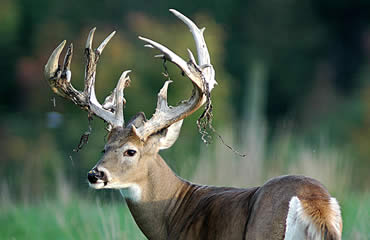
The philosophy of Buckmasters’ Full-Credit Scoring System is to measure and record white-tailed deer antlers without forcing them to conform to a criterion of perfect symmetry.
This Full-Credit Scoring System takes nothing away from the rack. It simply measures every inch of antler and classifies it accordingly. And, because simple mathematics determines in which category a rack belongs, we’ve removed the incentive for a measurer or hunter to make the call based on how a deer might rank.
To borrow a cliché, “It is what it is.”
Buckmasters’ system is based on the method of evaluating white-tailed deer antlers developed by Russell Thornberry, who recognized that other scoring systems’ symmetry-based formulas often were like shaving square pegs to fit into round holes. Thornberry’s system first appeared in print in “Trophy Deer of Alberta,” published in 1982. Adopted by Buckmasters in the mid-1990s, the Full-Credit Scoring System abandons the punitive pursuit of symmetry and simply gives a rack credit for the full amount of antler present.
The BTR (short for Buckmasters Whitetail Trophy Records) can be distinguished from other whitetail scoring systems in eight important areas.
1. No Deductions
The Buckmasters system does not deduct differences between lengths of opposing typical points or circumferences. Nor does it penalize a mostly typical rack for irregular growth.
When measuring typical tines, no deduction is made when one typical point does not have a matching point on the opposite antler. An example would be a 9-point rack with five typical points on one side and only four typical points on the other. The BTR does not force this rack to become a hypothetical 8-pointer by deducting the unmatched point.
Even a clean 4x4 rack can suffer from deductions with other systems. Say one brow tine is 8 inches long; the other is 4. Because of the difference in lengths, this set of antlers would get a 4-inch deduction by the B&C yardstick. And that’s before the other typical points and circumferences are compared to their mates. This, we believe, is unfair.
2. The Air Otherwise Known as Inside Spread
While a BTR Score is akin to a true gross score, inside spread included, we do not factor the spread measurement in ranking whitetails because it is a measurement of air, not antler. Imagine a set of whitetail antlers altered to a flexible state, so that the main beams could be spread wider or narrower. With other scoring systems, changing the inside spread measurement would affect the final score, either positively or negatively. However, in reality, the actual inches of antler would not be altered by widening or narrowing the inside spread. All that has really been altered is a measurement of air.
Since the inside spread between the main beams is not used to rank antlers, a whitetail with a broken skull plate can be entered into the BTR. Such specimens cannot be entered into other systems’ books.
3. Four vs. Two Antler Categories
To accommodate all possible configurations of antler, the BTR has four classifications: perfect, typical, semi-irregular and irregular.
4. Minimum Scores
There is no justifiable reason to penalize a rack’s score because of the origin of a point or the direction in which it grows. For this reason, BTR minimum scores will be the same across the four antler classifications.
NOTE: Minimum scores apply to the TOTAL INCHES of antler (sans spread). All firearms-harvested deer must score at least 140 inches. A minimum score of 105 inches is required for all deer felled by bow.
5. Rankings by Means Harvested
The BTR system provides separate categories for all types of firearms, including centerfire rifles, shotguns, pistols and blackpowder guns. For deer felled by arrows, there are individual categories for compounds, recurves, longbows and crossbows. The pickup category is for racks that have been found rather than harvested by a hunter (minimum score is 140). There is also a category for shed antlers, which are measured as a right or left antler, not as a pair. Minimum score for sheds is 75 inches.
6. No Drying Period
No drying time is required before antlers can be measured.
7. Velvet Category
The BTR has a separate category for antlers still in velvet. Thus, we do not require that a rack be stripped before it is officially measured.
8. High Fence Category
There is opportunity for entry for bucks taken behind game-proof fences of no less than 500 contiguous acres, unobstructed by cross-fencing or any other barrier, providing the deer (1) is not forced to obtain food or water, (2) has sufficient cover in which to seek sanctuary, (3) was born on the tract and not raised by hand, and (4) is otherwise hunted under fair chase conditions and according to the game laws of the state or province.